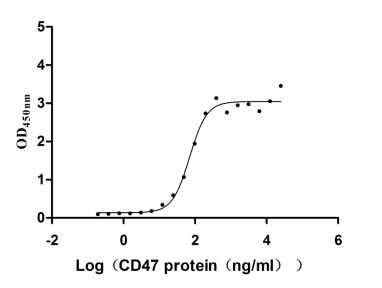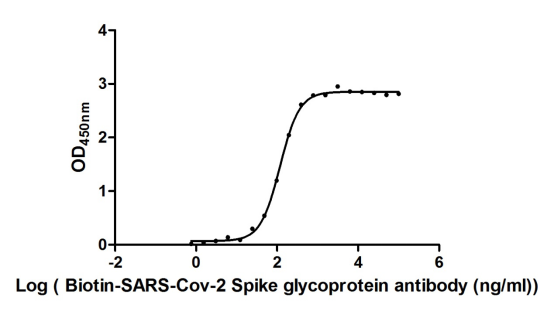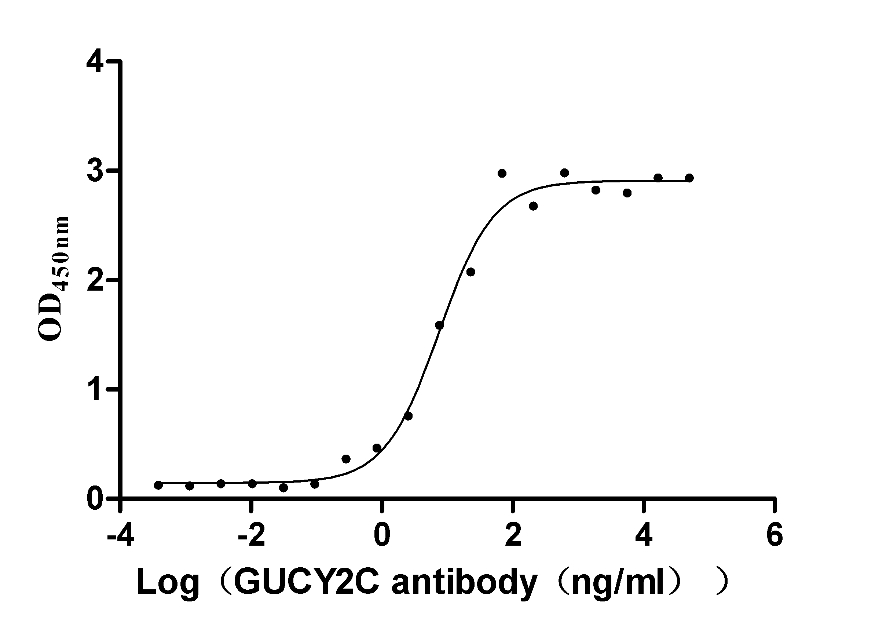Recombinant Mouse Nuclear receptor subfamily 1 group I member 2 (Nr1i2)
-
中文名称:小鼠Nr1i2重组蛋白
-
货号:CSB-YP016048MO
-
规格:
-
来源:Yeast
-
其他:
-
中文名称:小鼠Nr1i2重组蛋白
-
货号:CSB-EP016048MO
-
规格:
-
来源:E.coli
-
其他:
-
中文名称:小鼠Nr1i2重组蛋白
-
货号:CSB-EP016048MO-B
-
规格:
-
来源:E.coli
-
共轭:Avi-tag Biotinylated
E. coli biotin ligase (BirA) is highly specific in covalently attaching biotin to the 15 amino acid AviTag peptide. This recombinant protein was biotinylated in vivo by AviTag-BirA technology, which method is BriA catalyzes amide linkage between the biotin and the specific lysine of the AviTag.
-
其他:
-
中文名称:小鼠Nr1i2重组蛋白
-
货号:CSB-BP016048MO
-
规格:
-
来源:Baculovirus
-
其他:
-
中文名称:小鼠Nr1i2重组蛋白
-
货号:CSB-MP016048MO
-
规格:
-
来源:Mammalian cell
-
其他:
产品详情
-
纯度:>85% (SDS-PAGE)
-
基因名:
-
Uniprot No.:
-
别名:Nr1i2; PxrNuclear receptor subfamily 1 group I member 2; Orphan nuclear receptor PXR; Pregnane X receptor
-
种属:Mus musculus (Mouse)
-
蛋白长度:Full length protein
-
表达区域:1-431
-
氨基酸序列MRPEESWSRV GLVQCEEADS ALEEPINVEE EDGGLQICRV CGDKANGYHF NVMTCEGCKG FFRRAMKRNV RLRCPFRKGT CEITRKTRRQ CQACRLRKCL ESGMKKEMIM SDAAVEQRRA LIKRKKREKI EAPPPGGQGL TEEQQALIQE LMDAQMQTFD TTFSHFKDFR LPAVFHSGCE LPEFLQASLL EDPATWSQIM KDRVPMKISL QLRGEDGSIW NYQPPSKSDG KEIIPLLPHL ADVSTYMFKG VINFAKVISY FRDLPIEDQI SLLKGATFEM CILRFNTMFD TETGTWECGR LAYCFEDPNG GFQKLLLDPL MKFHCMLKKL QLHKEEYVLM QAISLFSPDR PGVVQRSVVD QLQERFALTL KAYIECSRPY PAHRFLFLKI MAVLTELRSI NAQQTQQLLR IQDSHPFATP LMQELFSSTD G
-
蛋白标签:Tag type will be determined during the manufacturing process.
The tag type will be determined during production process. If you have specified tag type, please tell us and we will develop the specified tag preferentially. -
产品提供形式:Lyophilized powder
Note: We will preferentially ship the format that we have in stock, however, if you have any special requirement for the format, please remark your requirement when placing the order, we will prepare according to your demand. -
复溶:We recommend that this vial be briefly centrifuged prior to opening to bring the contents to the bottom. Please reconstitute protein in deionized sterile water to a concentration of 0.1-1.0 mg/mL.We recommend to add 5-50% of glycerol (final concentration) and aliquot for long-term storage at -20℃/-80℃. Our default final concentration of glycerol is 50%. Customers could use it as reference.
-
储存条件:Store at -20°C/-80°C upon receipt, aliquoting is necessary for mutiple use. Avoid repeated freeze-thaw cycles.
-
保质期:The shelf life is related to many factors, storage state, buffer ingredients, storage temperature and the stability of the protein itself.
Generally, the shelf life of liquid form is 6 months at -20°C/-80°C. The shelf life of lyophilized form is 12 months at -20°C/-80°C. -
货期:Delivery time may differ from different purchasing way or location, please kindly consult your local distributors for specific delivery time.Note: All of our proteins are default shipped with normal blue ice packs, if you request to ship with dry ice, please communicate with us in advance and extra fees will be charged.
-
注意事项:Repeated freezing and thawing is not recommended. Store working aliquots at 4°C for up to one week.
-
Datasheet :Please contact us to get it.
靶点详情
-
功能:Nuclear receptor that binds and is activated by a variety of endogenous and xenobiotic compounds. Transcription factor that activates the transcription of multiple genes involved in the metabolism and secretion of potentially harmful xenobiotics, endogenous compounds and drugs. Response to specific ligands is species-specific, due to differences in the ligand-binding domain. Binds to a response element in the promoters of the CYP3A4 and ABCB1/MDR1 genes. Activated by naturally occurring steroids such as pregnenolone and progesterone, the cholesterol metabolite 5-beta-cholestane-3-alpha,7-alpha,12-alpha-triol, synthetic glucocorticoids and antiglucocorticoids and 16-alpha-carbonitrile (PCN).
-
基因功能参考文献:
- Pregnane X receptor (PXR, NR1I2) is a crucial regulator of nutrient metabolism and metabolic detoxification. PXR senses xenobiotics and triggers the detoxification response to prevent diseases such as diabetes, obesity, intestinal inflammatory diseases and liver fibrosis. Review. PMID: 28534176
- PXR deficiency suppresses chronic Ethanol-induced lipogenic gene induction. PMID: 29123032
- Results demonstrate that PXR acts as a rheostat in fine tuning the balance of innate inflammatory pathways through TLR4 to ensure protective immunity. PMID: 27550658
- Data suggest that regulation of SXR expression is involved in nephrosis induced by environmental poisons; here, nephrosis caused by atrazine herbicide poisoning can be mitigated by supplementation with antioxidant lycopene; in the kidney, mechanisms involved include modulation of SXR expression and of SXR transport to the nucleus. PMID: 29107825
- Both the acetylation and SUMOylation status of the PXR protein is affected by its ability to associate with the lysine de-acetylating enzyme HDAC3 in a complex with SMRT. PMID: 26883953
- The present study has revealed known and novel, as well as common and unique targets of PXR and CAR in mouse liver following pharmacological activation using their prototypical ligands. PMID: 27113289
- FGF21-PXR signaling pathway may be involved in decreased hepatic CYP3A4 metabolic activity in Nonalcoholic fatty liver disease. PMID: 27482056
- Pregnenolone 16alpha-carbonitrile has immunosuppressive activity independent of PXR activation to protect mice from immune-mediated liver injury induced by Con A. PMID: 28237809
- carcinogens might trigger PXR in epidermal cells, particularly in Langerhans cells, leading to DNA damage PMID: 26013842
- PXR activation stimulates EGF-mediated hepatocyte proliferation in mice, at least in part, through inhibiting FOXO3 from accelerating cell-cycle progression. PMID: 26574435
- The role of intestinal PXR in linking xenobiotic exposure and hyperlipidemia. PMID: 25811240
- modulation of vemurafenib bioavailability through pregnane X receptor-mediated regulation of drug transporters has the potential to markedly influence systemic exposure and thereby therapeutic outcomes. PMID: 26363009
- results indicate that SXR/PXR protects against aging-dependent wearing of articular cartilage and that ligands for SXR/PXR have potential role in preventing osteoarthritis caused by aging. PMID: 25749104
- Suggest a novel role for PXR signaling in the maintenance of intestinal homeostasis and may help to elucidate additional mechanisms through which PXR signaling is protective in inflammatory bowel disease. PMID: 24486481
- a direct chemical communication between the intestinal symbionts and PXR regulates mucosal integrity through a pathway that involves luminal sensing and signaling by TLR4. PMID: 25065623
- Role of pregnane X receptor in obesity and glucose homeostasis PMID: 24362030
- Xenobiotic-induced hepatocyte proliferation mediated by CAR or PPARalpha is enhanced by PXR co-activation despite the fact that PXR activation alone does not cause the cell proliferation in mouse livers. PMID: 23626729
- Results indicate that pregnane X receptor (PXR) represents a flow-activated detoxification system to protect endothelial cells (ECs) against damage by xeno- and endobiotics. PMID: 23878263
- Study reveals that alpha-tocopherol is a partial agonist of PXR and that PXR is necessary for Cyp3a induction by alpha-tocopherol in Pxr-null and PXR-humanized mice. PMID: 23160821
- Activation of PXR effectively inhibited the development of bleomycin-induced dermal fibrosis and induced the regression of established dermal fibrosis as assessed by skin thickening, hydroxyproline content and myofibroblasts. PMID: 23291432
- PXR expression remained unchanged by hypothyroidism PMID: 22503787
- PXR is a key regulator of pregnancy induced glucuronidation capacity in addition to modulating the severity of neonatal jaundice. PMID: 22371261
- CAR and PXR are closely associated and have diverse roles, both as positive and negative regulators of hepatic genes PMID: 22698814
- a unique role for SXR as a modulator of developmental hematopoiesis in the liver. PMID: 22496360
- Pregnane X receptor regulates drug metabolism and transport in the vasculature and protects from oxidative stress. PMID: 22166712
- Results provide a way to development of a dual PXR agonist/FXR antagonist with a robust immunomodulatory activity and endowed with the ability to modulate the expression of bile acid-regulated genes in the liver. PMID: 22285937
- Data show that pregnane X receptor (PXR) deficiency did not alter plasma lipid levels in apoE(-/-) mice, but PXR(-/-)apoE(-/-) mice had significantly decreased atherosclerotic cross-sectional lesion area. PMID: 21685500
- Pregnane X receptor activation induces FGF19-dependent tumor aggressiveness in humans and mice PMID: 21747170
- These results demonstrate a novel and unsuspected role for steroid and xenobiotic receptor (SXR) signaling in the B-1 cell compartment, establish SXR as a tumor suppressor in B-1 cells PMID: 21436254
- PXR prevented choelsterol gallstone disease via its coordinate regulation of the biosynthesis and transport of bile salts in the liver and intestine. PMID: 21354151
- analysis of hepatic transcriptional responses of wild-type (PXR(+/+)) and pregnane X receptor-knockout (PXR(-/-)) mice after 96 h exposure to CMP013, an inhibitor of beta-secretase PMID: 21203578
- investigation of role of PXR in regulation of gene expression regulation of placental drug transporters; results suggest a tissue-specific role for gene regulation by PXR PMID: 21127142
- Pregnane X receptor promotes bone formation and suppresses bone resorption, thus cementing a role for pregnane X receptor as a key regulator of bone homeostasis. PMID: 20876238
- studies demonstrate that the variant PXR isoform, mPXR(Delta171-211), has a distinct repressive function from mPXR(431) in regulating genes encoding important drug metabolizing enzymes and transport proteins PMID: 20060928
- PXR activation inhibits T cell proliferation and interferon (IFN)-gamma production and expression in vitro. PMID: 20173028
- loss of pregnane X receptor (PXR) potentiates lipopolysaccharide/D-galactosamine-induced hepatocyte apoptosis and liver injury PMID: 19997066
- Pxr plays only a limited role in mediating responses to gut-derived lithocholic acid PMID: 19797606
- PXR-null mice show inherited phenotype of hypophosphatemia and severe repression of Na/Pi cotransporter NaPi-IIb/Npt2b (SLC34A2) PMID: 19898264
- Reduction in cytochrome p-450 enzyme expression is associaated with repression of PXR PMID: 12054576
- PXR serves as a master regulator of the phase I and II responses to facilitate rapid and efficient detoxification and elimination of foreign chemicals. PMID: 12370413
- mouse PXR requires a specific agonist different from that required in humans to induce cyp3A expression PMID: 12569201
- PXR was retained in the cytoplasm of hepatic cells of untreated mice, whereas it was translocated to the nucleus after administration of a ligand; results provide evidence that nuclear import is mediated by bipartite type of nuclear localization signal PMID: 12606758
- HNF4alpha is the key transcription factor regulating responses to xenobiotics through activation of the PXR gene during fetal liver development. PMID: 12774017
- identified a drug-responsive enhancer in the ALAS1 gene activated by the pregnane X receptor and the constitutive androstane receptor PMID: 12881517
- farnesoid X receptor, pregnane X receptor, and constitutive androstane receptor protect against hepatic bile acid toxicity in a complementary manner, preventing overt hepatic damage by bile acids during cholestasis PMID: 12923173
- Lipopolysaccharide induced downregulation of nuclear Pregnane X receptor in mouse liver PMID: 15183191
- FOXO1 was found to be a coactivator to CAR- and PXR-mediated transcription. PMID: 15340055
- cytoplasmic constitutive active/androstane receptor retention protein mediates the retention of PXR in the cytosol and modulates the activation of PXR in response to Pregnenolone Carbonitrile treatment PMID: 15347657
- CAR and PXR function coordinately to regulate both xenobiotic and bile acid metabolism PMID: 15358766
- PXR plays a role in the down-regulation of several hepatic proteins during inflammation PMID: 15456840
显示更多
收起更多
-
亚细胞定位:Nucleus.
-
蛋白家族:Nuclear hormone receptor family, NR1 subfamily
-
数据库链接:
KEGG: mmu:18171
STRING: 10090.ENSMUSP00000023504
UniGene: Mm.8509
Most popular with customers
-
Express system: Mammalian cell
Species: Homo sapiens (Human)
-
Recombinant Severe acute respiratory syndrome coronavirus 2 Spike glycoprotein (S), partial (Active)
Express system: Mammalian cell
Species: Severe acute respiratory syndrome coronavirus 2 (2019-nCoV) (SARS-CoV-2)
-
Recombinant Human Heat-stable enterotoxin receptor (GUCY2C), partial (Active)
Express system: Mammalian cell
Species: Homo sapiens (Human)
-
Recombinant Human T-cell surface protein tactile (CD96), partial (Active)
Express system: Mammalian cell
Species: Homo sapiens (Human)
-
Recombinant Human IL12B&IL12A Heterodimer Protein (Active)
Express system: Mammalian cell
Species: Homo sapiens (Human)
-
Recombinant Human V-set and immunoglobulin domain-containing protein 4 (VSIG4), partial (Active)
Express system: Mammalian cell
Species: Homo sapiens (Human)
-
Express system: Mammalian cell
Species: Homo sapiens (Human)
-
Recombinant Human CD70 antigen (CD70), partial (Active)
Express system: Mammalian cell
Species: Homo sapiens (Human)





-AC1.jpg)














